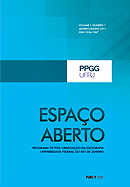Modelagem em Geografia Física: Teoria, Potencialidades e Desafios
DOI:
https://doi.org/10.36403/espacoaberto.2016.5243Palavras-chave:
modelagem, predição, validação, deslizamento, erosão dos solos, cenários futuros, simulação, equilíbrio dinâmico, relaxação, sensibilidadeResumo
A modelagem vem se consolidando como importante ferramenta de análise nos diferentes campos da geografia física. Este artigo busca uma reflexão sobre o uso de modelos na geografia física, discutindo suas bases teóricas, as principais potencialidades de aplicação e os maiores desafios a serem enfrentados. São aqui discutidos modelos voltados para a predição, para a retrodição e para o teste de hipóteses. Ênfase é dada à análise dos modelos matemáticos, sejam eles empíricos, determinísticos ou mesmo estocásticos, discutindo as vantagens e desvantagens do uso de modelos concentrados ou distribuídos, assim como transientes ou de equilíbrio. As diferenças entre as etapas de parametrização, calibração, validação e verificação durante o desenvolvimento de modelos são apresentadas e discutidas. Por último, são apresentados alguns dos principais problemas e desafios associados a um efetivo emprego de modelos na geografia física, com destaque para as relações entre modelagem e metodologia científica, a questão da equifinalidade e a determinação das incertezas envolvidas. A discussão aqui apresentada destaca que modelos com elevado grau de acerto não necessariamente representam “bons modelos” em termos conceituais. Para que a modelagem continue se consolidando como importante ferramenta de análise nos diversos campo da geografia física, torna-se fundamental que os usuários se dediquem à compreensão tanto do funcionamento do sistema a ser modelado quanto do modelo em si utilizado, seja em termos de sua estrutura interna ou das hipóteses ali envolvidas. Caso contrário, o usuário se tornará apenas um “piloto de software”, perdendo a oportunidade de transformar os bonitos mapas gerados em efetivas ferramentas de análise científica.


